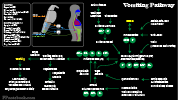II. Epidemiology
- Incidence of Postoperative Nausea and Vomiting (PONV): 30% (70% in high risk patients)
III. Pathophysiology
- See Vomiting
- Images
IV. Risk factors
- Patient characteristics with higher risk of Postoperative Nausea and Vomiting (PONV)
- Female gender
- History of Motion Sickness
- Prior episode Postoperative Nausea and Vomiting
- Non-smokers
- Postoperative use of opiod Analgesics
- Surgeries with higher PONV risk
- Craniotomy
- Ear, nose and throat surgery
- Major Breast surgery
- Laparoscopy or Laparotomy
- Strabismus surgery
- Cholecystectomy
- Bariatric Surgery
- Gynecologic Surgery
-
Anesthetics with higher PONV risk
- Opiod Analgesics
- Nitrous Oxide
- Volatile inhalational Anesthetics
V. Management: Medications
- Scopolamine Transdermal
- Dimehydrinate
- 5-HT3 Receptor Antagonist
-
Dopamine Receptor Antagonist
- Droperidol
- Amisulpride (Barhemsys)
- Haloperidol
- May use as alternative to Droperidol
- Give 0.5 to 1 mg IM or IV at Anesthesia induction or end of surgery
- Metoclopramide
- Less effective for PONV than other options (e.g. Ondansetron)
- Phenothiazines (Limited evidence of efficacy in PONV)
-
NK1 Receptor Antagonist (given before surgery)
- Aprepitant
- Rolipitant
VI. Prevention: Mild Risk of PONV (1-2 risk factors)
-
Dexamethasone
- Give 4 to 8 mg IV once for single dose at Anesthesia induction
- Not effective for treatment once Nausea, Vomiting is present
-
Scopolamine Transdermal 1 mg patch
- Apply on the evening before surgery (at least 2 hours before induction)
- Remove 24 hours after surgery (may be kept in place for up to 72 hours)
-
5-HT3 Receptor Antagonist (e.g. Ondansetron, Granisetron)
- Ondansetron 4 mg IV given in last 20 min of surgery
-
Droperidol (Inapsine)
- Not recommended as first line due to QT Prolongation
- However, EKG and monitoring precautions only apply for doses >= 2.5 mg IV/IM
- Combination given at end of surgery or within 20 min of Anesthesia
- Droperidol 0.625 to 1.25 mg IV and
- Dexamethasone 4 mg IV
- Not recommended as first line due to QT Prolongation
VII. Prevention: Moderate Risk of PONV (3-4 risk factors)
- 5-HT3 Receptor Antagonist (e.g. Ondansetron) with Dexamethasone
- 5-HT3 Receptor Antagonist (e.g. Ondansetron) with Droperidol
VIII. Prevention: High Risk of PONV (>4 risk factors)
- Combination agents in Mild to Moderate risk list above AND
- Total intravenous Anesthesia with Propofol AND
- High concentration oxygen (80%) intraoperatively
IX. References
- (2023) Postoperative Nausea and Vomiting Management, Presc Lett, #390431
- (2020) Med Lett Drugs Ther 62(1614): 205-7 [PubMed]
- Gan (2002) JAMA 287:1233-6 [PubMed]

